
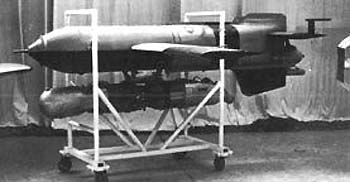
Henschel Hs 293 http://vectorsite.tripod.com/avbomb2.html#m2
The Henschel Hs 293, 294, 297 "Schmetterling" and 298
Henschel Hs 293 The beginning ideas that were to evolve into the Henschel Hs 293 appeared in as early as 1939. In 1940, an experimental model having the shape of a glider was built. The goal was to develope a remote-controlled air-to-surface missile against shipping. Development proceeded even though no suitable rocket motors were available. The experimental model used a standard SC 500 bomb with extra wings and tail unit but no rudder. Finally a propulsion system was developed, and the liquid rocket was fitted under the main missile body. An 18-channel radio system was used for control. The missile was designed to be carried under a parent bomber. Warm exhaust air from the aircraft engines was channeled to the missile to prevent it from freezing up at high altitudes. Once dropped the Hs 293 would fall for some 90m (295ft) before the rocket achieved maximum thrust. The parent bomber would continue to fly a predesignated course parallel with the target. The bombadier could visually track the missile with the aid of red guidance flare in the tail, and control the projectile using a small control box with a joystick. The actual flight path resembled a series of arcs as corrections were received and followed. The main weakness of the Hs 293A was that the parent bomber had to fly a steady, level path. Evasive moves to avoid anti-aircraft fire was impossible, even though the Hs 293 outranged most ship-borne anti-aircraft guns. An improved H2 293D with a television camera installed in the head of the missile as aiming system was planned but the war concluded before it could be realized. Also, the problem of icing was never resolved and thus further propulsion units were designed. The war ended before these plans left the experimental stage.
The Hs 293 was based on a normal 500 kg (1,102 lb) bomb with wings and fins added and an engine suspended from the main body. The Hs 293V-4 and C-1 were guided by radio, like the Fritz-X, but after the Germans found that the Allies were capable of interferring with the control signals to the missile wire guidance was adopted.
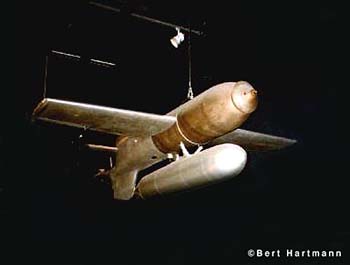
Henschel Hs 293 http://www.unsere-luftwaffe.de/archiv/motoren
The C-3, C-4, and A-0 versions of the Hs293 relied on a wire guidance. During the bomb's fall, two wired coils on the wing tips unwound, so maintaining the link with the launch plane and allowing the transmission of electrical impulses for guidance.
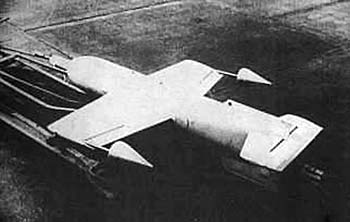
Henschel Hs 293 http://www.unsere-luftwaffe.de/archiv/motoren
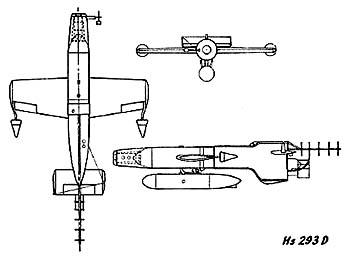
Henschel Hs 293 http://www.german-militaria.co.uk/lufteagle169.htm
Model A possessed an ogival armor piercing head. Models C had a conical shape to cleanly pass through the sea surface, close to broadside, and strike under the water line. A model D was also built, which transmitted television images of the target to the controller, and a model H which was supplied with an acoustic/magnetic detector to attack bomber formations....more 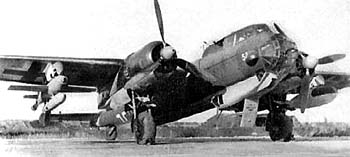
Henschel Hs 293 http://www.unsere-luftwaffe.de/archiv/motoren
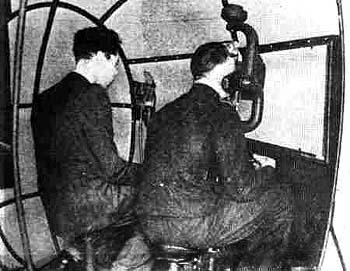 Crew members learn to control the Henschel Hs 293 guided bomb in a simulator. The guidance operators always sat on the starboard (right) side of the cabin, and therefore it was always necessary to attack a target from the port side and in the same movement direction. http://home.inreach.com/rickylaw/dictatorship/wonder/missile/hs293/hs293.html
Henschel Hs 293, Hs 294 : Air-to-Ship, Wireless Guided, Gliding Bombs http://www.unsere-luftwaffe.de/archiv/motoren/hs_293.htm
Henschel Hs 293 : Air-to-Ship, Wireless Guided, Gliding Bomb
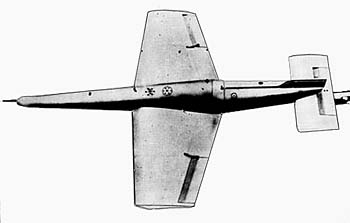
Henschel Hs 294 http://www.warbirdsresourcegroup.org/hs294.html
Henschel Hs 297, (Hs 117) Schmetterling 'Butterfly' Surface-to-Air Missile In 1941, a Professor Wagner conceived and designed the Schmetterling anti-aircraft missile and submitted it for appraisal and approval to the RLM (Reichsluftfahrtministerium, phew!) or the State Ministry of Aviation, which duly rejected the design because its defensive purpose was considered weak and still unnecessary in 1941. Official support finally came in 1943, when Allied strategic bombing had accelerated the war to a higher stage, and the Reich was feeling the pain. The Henschel company, which was also developing several other types of missiles, was given the go-ahead and development contract to begin production in February 1945. Experiments and production were interrupted by Allied bombers and there were only 59 experimental launchings, 34 of them failed for different reasons. Schmetterling was a bomb-shaped projectile with wings and fins, and two rocket boosters were attached to the outside for take-off. The external rockets were powered by solid fuel, while the internal motor was driven by a fuel composed of hydrocarbon and nitric acid. It could accelerate up to 537mph and had an effective range of approximately 10 miles with a ceiling of 35,000 feet. A ground controller would guide the missile through radio signals and track its course visually. The warhead contained 55lb of high explosive and was armed with a proximity fuze called "Fox."
Henschel Hs 298
Wolf William, German Guided Missiles - Henschel Hs 293 and Ruhrstahl SD 1400X "Fritz X", World War II Monograph 53, Merriam Press BOOK EXCERPT Introduction The lion's share of post-World War II literature concerning German guided missiles has concentrated on the V-1 "Buzz Bomb" and the V-2 stratospheric rocket. However, the guidance systems of these weapons were so rudimentary that a successful launch was one which hit a target as vast as London. German science developed several other, more sophisticated guidance systems for weapons which were used successfully in combat before either the V-1 or V-2. These first true guided missiles, by current definition, are virtually unknown today. They were Henschel's Hs 293A and Ruhrstahl's SD1400X, known as "Fritz X." Both missiles were air-launched from mother bombers and radio-controlled primarily against maritime targets. It is interesting to note that of the fifteen battleships lost to airpower (seven in the open sea) one of these, the 41,650-ton Italian flagship, Roma, was sunk by a Fritz X. Later, the British battleship, Warspite, was hit by a Fritz X and put out of action for six months. Fritz Xs also sunk the Royal Navy light cruiser, Spartan, heavily damaged the cruiser USS Savannah, and hit the cruiser USS Philadelphia. The Hs 293, meanwhile, was responsible for military history's first successful guided missile attack sinking the British sloop, Egret, on 27 August 1943. The following, for the first time, is the most complete story to date of these landmark weapons. Henschel Hs 293 : Air-to-Ship, Wireless Guided, Gliding Bomb Probably the most prolific factor in German missile development was Henschel FlugzeugWerke A.G. of Schonefeld near Berlin. Although the company had gone into aviation only in 1933, the RLM, fostering its interest in unmanned, guided aircraft development, contracted Henschel to continue its research and development program in 1939. Early work in the field had been initiated by Askania, DVL, Siemens and the Gustav Schwarz Propellerwerke in 1937. From their work the Schwarz unpowered glider bomb developed. The bomb, besides being aerodynamically unsuccessful, was tactically vulnerable as it was merely guided to the target on a straight line course under the control of an automatic pilot. At a high altitude release at long range the intended target would have time to prepare to defend itself while a low altitude release at short range put the carrying aircraft in jeopardy. The Henschel program received a great boost when the RLM assigned Prof. Dr. Herbert A. Wagner to assume control of their missile program. The brilliant Wagner had earlier been dismissed by Junkers Aircraft as the company found it impossible to reconcile his intermittent and desultory research methods with its ideas of series production. After his dismissal, he carried out independent research on an anti-shipping ricochet bomb. In January 1940, Wagner joined Henschel's already distinguished missile research team. This team of specialists included: Reinhard Lahde and Otto Bohlmann (aeronautics), Wilfried Hell, from Schwarz Propeller Werke (engineering), Josef Schwarzmann (electronics), and Dr. Hinrici (design study). Theodor Sturm of Stassfurter Rundfunk Gessellschaft worked closely with the Henschel team in developing and adapting radio systems. Since the RLM specification called for Henschel to direct its attention to developing remotely controlled air-to-surface missiles, the team began to work with the Schwarz design which was soon found to be inadequate, requiring extensive redesign and modification. The original Schwarz glider was controlled via rudder and elevators but Wagner felt that ailerons gave better control and incorporated a fixed fin and ailerons. The first Henschel design, designated Hs 293V-1, was a standard glider bomb bearing slight resemblance to its Schwarz forerunner. The Hs 293V-1 did not leave the drawing board. The second design, the Hs 293V-2 (later FZ21) was built as a model in February 1940 and used in control tests at Karlshagen. It, too, was unarmed and powerless. Note that, unlike German aircraft prototype 'V' numbers where only one example was built for each V number, the Henschel missile V numbers referred to design alone and many examples could have been built. Further studies led to a new design in July 1940, the Hs 293V-3. The powerless prototype was test launched from minimum release altitudes of 3,280 feet. Since the RLM was primarily interested in an anti-shipping missile, it was found that a pure glide bomb lacked sufficient speed and weight to penetrate warship hulls. The size and weight of the Henschel designs in 1940 were necessarily limited by the smallness of the Luftwaffe's operational bombers which were to carry the missiles. To increase target penetration it was decided to develop the Hs 293A-0 in late 1940. This model was equipped with an under slung Walter liquid bi-fuel rocket pod which allowed the missile to be released at an altitude of 1,315 feet which lent more accuracy without sacrificing acceptable protective range. The first flight trials of the A-0 version were carried out before wind tunnel data was evaluated. The first tests were conducted on 16 December and resulted in failure as the right and left controls were switched. It is interesting to note that the U.S. Mariner space probe failed in its trials in the early 1960s for the same reason. The first successful test launching occurred two days later against a small barn as a target. Subsequent tests ended in failure usually for two main reasons. First, the original white tracking flares were difficult to follow and were replaced with red flares. Secondly, the electrical system often failed due to design failure particularly with tubes which were replaced with relays. In 1941, drop tests used a Heinkel He 177A-0 bomber and later two He 177A-1s were used in the first successful tests. The A-0 design led to the finalization of the production design, the Hs 293A-1, which consisted of three pre-production models (V-2, V-3, A-0). One thousand nine hundred were produced for the test and modification programs which continued into early 1944 (1,700 were A-0s). Early Hs 293 production was carried out at Henschel Werke 111, Spandau-Hakenfelde but was transferred to Berlin-Schoenfeld in August 1943. The arsenal at Hesedorf, located between Hamburg and Bremen received the missile in five large wooden crates from component manufacturers. Box 1 contained the warhead which was rough machined at Witt Kowitz Steel, finished at Hens and loaded at Wasag. Box 2 contained the fuselage which was fabricated at Henschel and assembled along with the elevator and stabilizer fins. Included was the Henschel-made wing with aileron solenoids by Hornasser. The Henschel control panel with terminal box Sag 230 by Donag, gyroscope by Horn, batteries by DEAG and filters by OPTA Radio completed Box 2. Box 3 contained the E230 Receiver from Strassburg. Box 4 contained the Walter rocket motor while Box 5 contained a R-B fuse. Later, Box 3 was eliminated and the radio receiver was assembled with the control panel. Many tests were conducted on each component by the manufacturer and then at the Hesedorf arsenal. The Hs 293A was essentially a small monoplane built around an SC 500 bomb warhead. The entire length of the missile was 11 feet 87/8 inches with a diameter of 1 foot 67/8 inches. The anterior fuselage housed the thin-walled SC 500 demolition warhead containing 649 pounds of explosive charge. The warhead contained Trialen 105 explosive (15 percent RDX, 70 percent TNT, and 15 percent aluminum to increase the blast effect). An impact fuse was fitted to the warhead. Since the warhead was of this type and the impact velocity was low at 450 miles per hour, there was small penetration capability. Thus the missile's effect was greatest against lightly armored warships (e.g., destroyers) and thin-skinned freighters. and now... The Ruhrstahl SD 1400 'Fritz X' : Air-to-Ship, Wireless Guided, Gliding Bomb In 1938, Dr. Max Kramer of Ruhrstahl A.G., Westfalen, tested methods of correcting errors in falling bombs, using radio-controlled spoilers located in the tails of 550 pound bombs. In 1940, the RLM adopted Kramer's control system utilizing the SD 1400X armor-piercing bomb. The German 100 kilogram bomb had always been known as "Fritz" so its code name became "Fritz X" and its code designation, "FX" or "FX 1400." Ruhrstahl continued with its manufacturer's designation of "X-1" which led to Fritz X variants, X-1 through X-7. The "X" was a classification used by Ruhrstahl to denote all their missiles with cruciform tails. The operational missile was later referred to as "Korper" or body by security-conscious personnel. In early tests, bomb-aimers had difficulty following the bomb in flight due to its high velocity. Also, the electromagnetically activated spoilers tended to jam. Pneumatic power was tested but was found to develop problems in low temperatures causing the electromagnetic system to be retained. It was not until early 1942, when a high-speed wind tunnel had been constructed, that Dr. Kramer's control spoilers were modified and that a velocity-reducing tail-mounted air brake was perfected. Tests, beginning in February 1942 at Karlshagen and Peenemünde-West, showed that the bomb had to be dropped from a minimum height of 13,000 feet if there was to be enough time for the bomb aimer to correct the flight of the bomb. The need for more favorable weather conditions to conduct tests from this height caused the program to be transferred to Erprobungsstelle Sud at Foggia, Italy. Here, Dr. Kramer was able to complete developmental tests in an amazing time of only a month. At 23,000 feet, half of the test bombs hit within a 50-foot radius while 90 percent hit within a 100-foot radius when controlled by experienced bomb aimers. As issued the Fritz X was the standard SD 100X armor-piercing (AP) bomb with four centrally-mounted standard cruciform wings giving the bomb aerodynamic pivotal points for control. The total span across the wings was 4 feet 5 inches. The tail assembly consisted of four fins similar to those of an orthodox bomb, but were surrounded by the air brake ring which contained the control spoilers and operating solenoids. The dive brake was fitted around the tail fins to limit the terminal velocity of the bomb to 600 miles per hour. The dive brake was fabricated of metal but a section was electrically insulated to serve as a radio antenna. The fuselage and tail measured 10 feet 8* inches and had a diameter of 1 foot 10 inches. A bright flare unit ("Leuchtstaz") was contained in the tail unit to assist the bomb aimer in following the course of the falling, rapidly diminishing bomb. Early flares left a smoke trail which was so dense as to obscure the target. The red tracer was tried but it was sometimes lost in anti-aircraft red tracer. Green was tried next with a blue-white smokeless type finally settled on. An alternative tracking aid was a blue electric lamp, but since it required an additional battery it was not commonly used. In early tests it was found that half of the flares failed. It was found that the plastic base of the flare deteriorated in storage. The total operational weight of Fritz X was 3,454 pounds. The missile was usually painted a light blue to match the underside of the Do 217, which generally carried the bomb operationally. Dr. Kramer, from his previous aerodynamic investigations, choose from the beginning of the Fritz X project the then little-known oscillator principle of aerodynamic control. He did so because it promised a simple method of transmitting steady control movement in conjunction with remote control. The principle major disadvantage of increased drag and long delay in control transmission at low speed would not be vital in the project. There were three pairs of tail-mounted spoilers, each of the six was located between boundary layer fences and was operated by an electromagnet located in the largest section of that particular tail fin. Unlike the Wagner spoilers found on the Henschel missiles the Fritz X spoilers passed through the electromagnetic coils and were operated by them. The drag of the tail fins was altered by the spoilers, which were small metal plates projecting on command into the air stream. No control command had both spoilers projecting equally into the air stream. When a control command was given one spoiler projected into the air stream to cause a directional response. Pitch and yaw commands, directed by the bomb aimer, were performed by the spoilers of the horizontal and vertical tail fins respectively. The third set of spoilers were connected to the gyroscope so as to operate in opposition giving roll stabilization. These spoilers were located in the horizontal fin. The disadvantage of drag and disrupted air flow caused by the spoilers was compensated for by their ease and low expense of manufacture, use of existing electrical power, and their adaptation to a simple radio control system. The 24 volt battery supplied power for the gyroscope and radio receiver generator along with direct current to the spoiler electromagnetics. The FuG 203/230 radio control unit used a 203a Kehl I transmitter on the aircraft and 230a Strassburg receiver on the Fritz X. Later transmissions beginning with Kehl IV were interchangeable with those used on the Hs 293. The Duran/Detmold FuG 208/238 wire control system was also developed for Fritz X use. A direct current to the spoiler electromagnets flowed through two .22 mm transmission wires which unwound to a five mile maximum from tail bobbins. An air raid on development facilities caused the wire transmission project's abandonment. The bomb aimer had two control panels to direct. The first panel contained two switches. One switch started the gyroscope and activated the radio receiver in the bomb while the other switch activated the radio transmitter in the aircraft. The second panel contained four gauges. A voltmeter and ammeter gave battery readings on the bomb. The "H" ("Hitze" = heat) gauge gave the temperature in the bomb's rear fuselage "nerve center." Due to the cold outside temperatures at the high altitudes the bomb was released from the control components needed to be heated to 86 degrees Fahrenheit (30 degrees Centigrade). Hot air from the aircraft's deicing system was fed into the bomb prior to launching. The "G" ("Geradlaufapparat") gauge gave gyroscopic function readings. Below the gauges on this panel was a switch to activate the control apparatus at least two minutes before release. The bomb aimer took the normal kneeling position over a standard Lofte 7D bomb sight. To the left of the sight was the bomb release control with the overriding button ("Kursgeber") in front of it. The Kursgeber allowed the bomb aimer to control the aircraft's approach to the target and the run in procedure was similar to that on a normal bomb run. The Fritz X was tactically designed to do everything an armor-piercing bomb of the same weight could do. The bomb aimer needed a well-defined target which could be readily discerned from its surroundings. Since the mother aircraft was required to slow down to allow the bomb aimer to track the bomb it was even more vulnerable to anti-aircraft fire than the Hs 293 mother aircraft which launched from further away. Therefore, sea targets not heavily defended by anti-aircraft fire were ideal.
The sudden but arranged capitulation of the Italian fleet to the Allies on 9 September 1943 spurred the Germans to take quick actions against their former ally. The battleship Italia was damaged and Roma sunk as victims of a new type of air-to-surface weapon, the Ruhrstahl/Kramer X-1 or Fritz X. It was a free-falling bomb guided by the parent aircraft. Usually it was dropped at an altitude of about 6,000m (19,685ft); by the time of detonation it would have had gained a velocity close to that of sound. The control apparatus comprised of electromagnetically operated spoilers activated in sympathy with radio signals from the parent aircraft (often a Dornier Do 217). After dropping the Fritz X, the airplane would have its motors throttled back and be flown to a higher altitude directly above the target, thus enabling the observer to guide the missile with a conventional Lofte 7 bombsight. Direct wire-link control using transmission lines that were 8km (4.97 miles) long was also possible. However, it was later abandoned for economic reasons. The first tests were conducted in Germany in 1942, and were moved to Italy later. In Italy, pneumatic power was tested to substitute for the electromagnetic actuation of the spoilers. However, variations in temperature in different parts of the atmosphere posed obstacles and the idea had to be dropped. The Allied advance to Italy forced the Germans to press the Fritz X into increased use. The cruiser USS Savannah was attacked successfully alongside several naval transports. During a night attack two British cruisers collided in utmost confusion. Seven days later the Germans scored hits on the battleship HMS Warspite, which had to be towed to Malta. Each month about 66 of these guided bombs were manufactured, far less than the projected figure. About half of the bombs were consumed by tests done during 1943 and 1944. The real obstacle to the success of the Fritz X program was not the low production rate, but the substantial loss suffered by the deliverer aircraft. The parent planes were very vulnerable because fairly slow speed was needed over the target area.
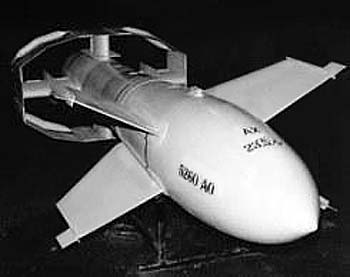
The Ruhrstahl SD 1400 'Fritz X' http://www.unsere-luftwaffe.de/archiv/motoren/fritz_x.htm
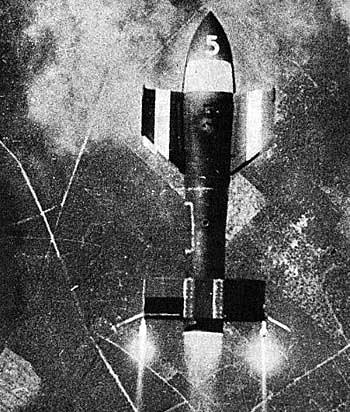
The Ruhrstahl SD 1400 'Fritz X' http://www.german-militaria.co.uk/lufteagle179.htm
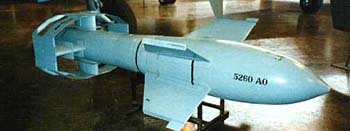
The Ruhrstahl SD 1400 'Fritz X' citation tba
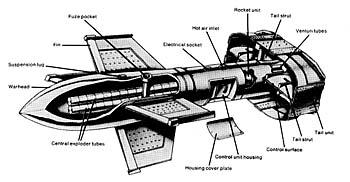
The Ruhrstahl SD 1400 'Fritz X' citation tba You may wish to download a 750pixel version of this image
"Secrets of War" : The Henchell HS-139 and 'Fritz X' "The following is part of a raw transcript of an on-camera interview (#S3147) conducted in 1998 with Mr. Paul Beaver for "Secrets of War."" The original goes on to say..."Please keep in mind that these transcripts are truly "raw" and thus have not been edited or checked for spelling and accuracy. All rights reserved. © 1998 The Documedia Group." Q: Tell us about the Henchell HS-139. PB: Give me some more.... Q: Radio controlled glider bomb that was used at Anzio, and tell us about the sinking of the battleship Roma.. PB: The Germans were reasonably far advanced with strike weapons, particularly with glide bomb weapons. They had developed a system where they could take a reasonably large explosive warhead onto an unmanned air vehicle if you like, remotely piloted vehicle. You could launch it outside the defensive range of a ship, and in the case of the Battle of Anzio uh, it was the large Italian battle ship, the Roma that was the target. Launched it outside the target area, or the defensive area of the ship and then you flew it to the target as if you'd fly a radio controlled airplane to day. The Germans were in 1943 already operational with this system. It was a major concern that if they could do this against a battle ship what happens when the allies were going to uh, invade Norway, uh, let's start it all again. I had the wrong country.. (off camera). By 1943 the Germans had developed their precision strike weapons to such a degree that they would develop a remotely piloted vehicle which had a warhead, and could be flown to the target. ..?.. aircraft which was outside a target's defensive capabilities, so indicates to the Battle of Anzio, it was the Italian battleship Roma, recently changed sides from being accessed to ally, the prime target for them in terms of a morale booster. They were able to launch the glide bomb from the carrying aircraft and a pilot on board carrying aircraft, actually literally flew back into flyer radio controlled airplane today, penetrated the defenses, hit the target and didn't need to have a very large warhead to be able to plunge and attack straight through to a target area which had been pre-defined. It was that accurate. You could actually fly it into, not just to hit the ship, but to hit the part of the ship you needed.. Q: What was the range of something like that?. PB: The ranges of glide bombs depend on the strength of the radio signal, and the capability of the pilot to fly it, and to a certain extent the where you can launch it in terms of the pure geometry. But you're talking, you'd be able to launch it at several miles from the target, so outside the normal defenses of the ship.. Q: Okay, could you tell us about 'Fritz X', the radio controlled ..?... gravity smart bomb?. PB: Well once the Germans had started to uh, uh, look at the whole Fritz program of glide bombs, they were looking at other systems, and they developed a whole family of weapons that were basically glide bombs that were precision glided, guided, that could actually cruise, of you like, because they could, they could, they were so aerodynamically shaped that they could move through the air with the least amount of drag. They could cover quite large distances, and they could plunge an attack with a very good warhead, and they could attack not any ships at sea, but uh, uh, pill boxes and defensive positions. The one risk that the allies had was that these systems that came to the battle of Normandy would be used against the troop transports, and of course the amendous...., tremendous loss of life. And that was a real threat.. Q: Did the Germans anticipate and create basically the first t.v. camera smart bombs?. PB: I think there's no doubt at all that what we would today call smart weapons were, were really invented at Operation NUA-1, the Germans. Not only were they looking at radio controlled bombs, glide bombs, they were looking at powered bombs, they were looking at remotely piloted aircraft, they were looking at cruise weapons that could be launched at stand off ranges. They were looking also at putting televisions cameras in the noses of ..?.. to be able to steer them with pin point accuracy onto targets. Television was in its infancy. The first broadcast had only been made in 1936, so we're talking at something that was pretty high technology at the time. Militarization as a real problem to them, power sources were also a problem. But they were working in that direction. Uh, I've not been able to find any good records to show that they actually ..?... operational system, but they were close to two or three years they would have gotten there.. Q: Okay, how were these various weapons systems first discovered?. PB: I don't know if a, from an allied point of view, the first time that weapons of, like the glide bomb, ..?.. glide bomb were discovered is when they were flown, when they hit the targets. That was perhaps one of the major problems of, or the very few problems that uh, allies intelligence had was actually finding out about the development of these precision guided weapons. It's probably because the technologies involved were so revolutionary that people didn't fully understand what intelligence information is, was being filtered back. But I think it took everyone by surprise when the first glide bombs appeared in the Mediterranean.
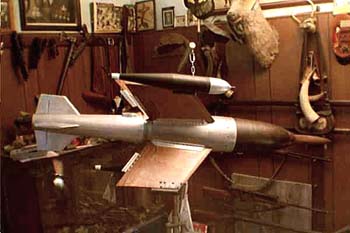 Restored Ruhrstahl X-4 : Air-to-Air missile http://members.aol.com/_ht_a/rayeso/index.html/mainpage.html
http://home.inreach.com/rickylaw/dictatorship/wonder/missile/x-4/x-4.html German wire-guided missiles belong generally to the X-series. The X-4, an air-to-air missile, was the first of the series to be developed in June 1943. It was a finned and winged projectile with a wingspan of 6ft 6in, and powered by a rocket using a combination of two fuels (T and C stoff). The wire, coiled around spools, was stored in the wing tips and carried guidance signals to control spoiler tabs and ailerons on the wings to alter direction. The warhead composed of 44lb of explosive and a acoustic proximity fuze called "Kranich." Experimental models were tested and flown with satisfying results in September 1944, but the wire link was inevitably perceived as too restrictive, since it was certainly not a fire-and-forget missile. Two other alternatives were suggested and tried out, one employing the "Pudel" acoustic homing system so the missile would be attracted to the noise of the target's engines, and the other used radio link system of guidance. Neither of the proposal was developed beyond experimental stage when the war ended in May 1945. It was certainly natural and reasonable that a ground-to-ground version of the X-4 was also developed, as an anti-tank weapon, in addition the the successful Panzerfaust. This new cousin missile was called the X-7. The X-7 was navigated and stabilized by a gyroscope and guided by wire, like the X-4, but it contained a hollow charge warhead armed with an impact fuze which could penetrate over 200mm of armor within 1000 meters. It was driven by a two-stage, solid-fuel rocket motor and weighed 22lb. The Ruhrstahl AG company of Düsseldorf developed the X-series of missiles. However, like many other German wonder weapons, none of the versions were perfected to proceed to production stage before the Reich surrendered. But it is only fair to give credit to the company and its scientists for being the inventors and developers of wire-guided anti-tank missiles. Today, the anti-armor missiles are very similar to the original blueprints of X-7 and are popular among many nations.
In early 1943, work began on the X-4 air-to-air wire-guided missile by Dr. Kramer at Ruhrstahl. The missile received a development order in the summer of 1943 and was given the number 8-344 by the RLM, and was developed to give fighters a chance to down the ever increasing number of Allied bombers from outside of their defensive gun range....more
|
© Copyright 1999-2003 CTIE - All Rights Reserved - Caution |